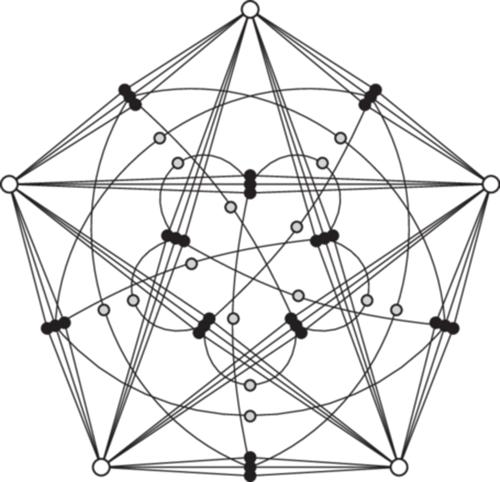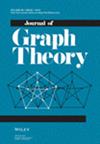下载PDF
{"title":"最大平均度数小于 4 的图形正方形中的小群","authors":"Daniel W. Cranston, Gexin Yu","doi":"10.1002/jgt.23125","DOIUrl":null,"url":null,"abstract":"<p>Hocquard, Kim, and Pierron constructed, for every even integer <span></span><math>\n <semantics>\n <mrow>\n \n <mrow>\n <mi>D</mi>\n \n <mo>≥</mo>\n \n <mn>2</mn>\n </mrow>\n </mrow>\n <annotation> $D\\ge 2$</annotation>\n </semantics></math>, a 2-degenerate graph <span></span><math>\n <semantics>\n <mrow>\n \n <mrow>\n <msub>\n <mi>G</mi>\n \n <mi>D</mi>\n </msub>\n </mrow>\n </mrow>\n <annotation> ${G}_{D}$</annotation>\n </semantics></math> with maximum degree <span></span><math>\n <semantics>\n <mrow>\n \n <mrow>\n <mi>D</mi>\n </mrow>\n </mrow>\n <annotation> $D$</annotation>\n </semantics></math> such that <span></span><math>\n <semantics>\n <mrow>\n \n <mrow>\n <mi>ω</mi>\n \n <mrow>\n <mo>(</mo>\n \n <msubsup>\n <mi>G</mi>\n \n <mi>D</mi>\n \n <mn>2</mn>\n </msubsup>\n \n <mo>)</mo>\n </mrow>\n \n <mo>=</mo>\n \n <mfrac>\n <mn>5</mn>\n \n <mn>2</mn>\n </mfrac>\n \n <mi>D</mi>\n </mrow>\n </mrow>\n <annotation> $\\omega ({G}_{D}^{2})=\\frac{5}{2}D$</annotation>\n </semantics></math>. We prove for (a) all 2-degenerate graphs <span></span><math>\n <semantics>\n <mrow>\n \n <mrow>\n <mi>G</mi>\n </mrow>\n </mrow>\n <annotation> $G$</annotation>\n </semantics></math> and (b) all graphs <span></span><math>\n <semantics>\n <mrow>\n \n <mrow>\n <mi>G</mi>\n </mrow>\n </mrow>\n <annotation> $G$</annotation>\n </semantics></math> with <span></span><math>\n <semantics>\n <mrow>\n \n <mrow>\n <mtext>mad</mtext>\n \n <mrow>\n <mo>(</mo>\n \n <mi>G</mi>\n \n <mo>)</mo>\n </mrow>\n \n <mo><</mo>\n \n <mn>4</mn>\n </mrow>\n </mrow>\n <annotation> $\\text{mad}(G)\\lt 4$</annotation>\n </semantics></math>, upper bounds on the clique number <span></span><math>\n <semantics>\n <mrow>\n \n <mrow>\n <mi>ω</mi>\n \n <mrow>\n <mo>(</mo>\n \n <msup>\n <mi>G</mi>\n \n <mn>2</mn>\n </msup>\n \n <mo>)</mo>\n </mrow>\n </mrow>\n </mrow>\n <annotation> $\\omega ({G}^{2})$</annotation>\n </semantics></math> of <span></span><math>\n <semantics>\n <mrow>\n \n <mrow>\n <msup>\n <mi>G</mi>\n \n <mn>2</mn>\n </msup>\n </mrow>\n </mrow>\n <annotation> ${G}^{2}$</annotation>\n </semantics></math> that match the lower bound given by this construction, up to small additive constants. We show that if <span></span><math>\n <semantics>\n <mrow>\n \n <mrow>\n <mi>G</mi>\n </mrow>\n </mrow>\n <annotation> $G$</annotation>\n </semantics></math> is 2-degenerate with maximum degree <span></span><math>\n <semantics>\n <mrow>\n \n <mrow>\n <mi>D</mi>\n </mrow>\n </mrow>\n <annotation> $D$</annotation>\n </semantics></math>, then <span></span><math>\n <semantics>\n <mrow>\n \n <mrow>\n <mi>ω</mi>\n \n <mrow>\n <mo>(</mo>\n \n <msup>\n <mi>G</mi>\n \n <mn>2</mn>\n </msup>\n \n <mo>)</mo>\n </mrow>\n \n <mo>≤</mo>\n \n <mfrac>\n <mn>5</mn>\n \n <mn>2</mn>\n </mfrac>\n \n <mi>D</mi>\n \n <mo>+</mo>\n \n <mn>72</mn>\n </mrow>\n </mrow>\n <annotation> $\\omega ({G}^{2})\\le \\frac{5}{2}D+72$</annotation>\n </semantics></math> (with <span></span><math>\n <semantics>\n <mrow>\n \n <mrow>\n <mi>ω</mi>\n \n <mrow>\n <mo>(</mo>\n \n <msup>\n <mi>G</mi>\n \n <mn>2</mn>\n </msup>\n \n <mo>)</mo>\n </mrow>\n \n <mo>≤</mo>\n \n <mfrac>\n <mn>5</mn>\n \n <mn>2</mn>\n </mfrac>\n \n <mi>D</mi>\n \n <mo>+</mo>\n \n <mn>60</mn>\n </mrow>\n </mrow>\n <annotation> $\\omega ({G}^{2})\\le \\frac{5}{2}D+60$</annotation>\n </semantics></math> when <span></span><math>\n <semantics>\n <mrow>\n \n <mrow>\n <mi>D</mi>\n </mrow>\n </mrow>\n <annotation> $D$</annotation>\n </semantics></math> is sufficiently large). And if <span></span><math>\n <semantics>\n <mrow>\n \n <mrow>\n <mi>G</mi>\n </mrow>\n </mrow>\n <annotation> $G$</annotation>\n </semantics></math> has <span></span><math>\n <semantics>\n <mrow>\n \n <mrow>\n <mtext>mad</mtext>\n \n <mrow>\n <mo>(</mo>\n \n <mi>G</mi>\n \n <mo>)</mo>\n </mrow>\n \n <mo><</mo>\n \n <mn>4</mn>\n </mrow>\n </mrow>\n <annotation> $\\text{mad}(G)\\lt 4$</annotation>\n </semantics></math> and maximum degree <span></span><math>\n <semantics>\n <mrow>\n \n <mrow>\n <mi>D</mi>\n </mrow>\n </mrow>\n <annotation> $D$</annotation>\n </semantics></math>, then <span></span><math>\n <semantics>\n <mrow>\n \n <mrow>\n <mi>ω</mi>\n \n <mrow>\n <mo>(</mo>\n \n <msup>\n <mi>G</mi>\n \n <mn>2</mn>\n </msup>\n \n <mo>)</mo>\n </mrow>\n \n <mo>≤</mo>\n \n <mfrac>\n <mn>5</mn>\n \n <mn>2</mn>\n </mfrac>\n \n <mi>D</mi>\n \n <mo>+</mo>\n \n <mn>532</mn>\n </mrow>\n </mrow>\n <annotation> $\\omega ({G}^{2})\\le \\frac{5}{2}D+532$</annotation>\n </semantics></math>. Thus, the construction of Hocquard et al. is essentially the best possible. Our proofs introduce a “token passing” technique to derive crucial information about nonadjacencies in <span></span><math>\n <semantics>\n <mrow>\n \n <mrow>\n <mi>G</mi>\n </mrow>\n </mrow>\n <annotation> $G$</annotation>\n </semantics></math> of vertices that are adjacent in <span></span><math>\n <semantics>\n <mrow>\n \n <mrow>\n <msup>\n <mi>G</mi>\n \n <mn>2</mn>\n </msup>\n </mrow>\n </mrow>\n <annotation> ${G}^{2}$</annotation>\n </semantics></math>. This is a powerful technique for working with such graphs that has not previously appeared in the literature.</p>","PeriodicalId":16014,"journal":{"name":"Journal of Graph Theory","volume":"107 3","pages":"559-577"},"PeriodicalIF":0.9000,"publicationDate":"2024-07-02","publicationTypes":"Journal Article","fieldsOfStudy":null,"isOpenAccess":false,"openAccessPdf":"https://onlinelibrary.wiley.com/doi/epdf/10.1002/jgt.23125","citationCount":"0","resultStr":"{\"title\":\"Cliques in squares of graphs with maximum average degree less than 4\",\"authors\":\"Daniel W. Cranston, Gexin Yu\",\"doi\":\"10.1002/jgt.23125\",\"DOIUrl\":null,\"url\":null,\"abstract\":\"<p>Hocquard, Kim, and Pierron constructed, for every even integer <span></span><math>\\n <semantics>\\n <mrow>\\n \\n <mrow>\\n <mi>D</mi>\\n \\n <mo>≥</mo>\\n \\n <mn>2</mn>\\n </mrow>\\n </mrow>\\n <annotation> $D\\\\ge 2$</annotation>\\n </semantics></math>, a 2-degenerate graph <span></span><math>\\n <semantics>\\n <mrow>\\n \\n <mrow>\\n <msub>\\n <mi>G</mi>\\n \\n <mi>D</mi>\\n </msub>\\n </mrow>\\n </mrow>\\n <annotation> ${G}_{D}$</annotation>\\n </semantics></math> with maximum degree <span></span><math>\\n <semantics>\\n <mrow>\\n \\n <mrow>\\n <mi>D</mi>\\n </mrow>\\n </mrow>\\n <annotation> $D$</annotation>\\n </semantics></math> such that <span></span><math>\\n <semantics>\\n <mrow>\\n \\n <mrow>\\n <mi>ω</mi>\\n \\n <mrow>\\n <mo>(</mo>\\n \\n <msubsup>\\n <mi>G</mi>\\n \\n <mi>D</mi>\\n \\n <mn>2</mn>\\n </msubsup>\\n \\n <mo>)</mo>\\n </mrow>\\n \\n <mo>=</mo>\\n \\n <mfrac>\\n <mn>5</mn>\\n \\n <mn>2</mn>\\n </mfrac>\\n \\n <mi>D</mi>\\n </mrow>\\n </mrow>\\n <annotation> $\\\\omega ({G}_{D}^{2})=\\\\frac{5}{2}D$</annotation>\\n </semantics></math>. We prove for (a) all 2-degenerate graphs <span></span><math>\\n <semantics>\\n <mrow>\\n \\n <mrow>\\n <mi>G</mi>\\n </mrow>\\n </mrow>\\n <annotation> $G$</annotation>\\n </semantics></math> and (b) all graphs <span></span><math>\\n <semantics>\\n <mrow>\\n \\n <mrow>\\n <mi>G</mi>\\n </mrow>\\n </mrow>\\n <annotation> $G$</annotation>\\n </semantics></math> with <span></span><math>\\n <semantics>\\n <mrow>\\n \\n <mrow>\\n <mtext>mad</mtext>\\n \\n <mrow>\\n <mo>(</mo>\\n \\n <mi>G</mi>\\n \\n <mo>)</mo>\\n </mrow>\\n \\n <mo><</mo>\\n \\n <mn>4</mn>\\n </mrow>\\n </mrow>\\n <annotation> $\\\\text{mad}(G)\\\\lt 4$</annotation>\\n </semantics></math>, upper bounds on the clique number <span></span><math>\\n <semantics>\\n <mrow>\\n \\n <mrow>\\n <mi>ω</mi>\\n \\n <mrow>\\n <mo>(</mo>\\n \\n <msup>\\n <mi>G</mi>\\n \\n <mn>2</mn>\\n </msup>\\n \\n <mo>)</mo>\\n </mrow>\\n </mrow>\\n </mrow>\\n <annotation> $\\\\omega ({G}^{2})$</annotation>\\n </semantics></math> of <span></span><math>\\n <semantics>\\n <mrow>\\n \\n <mrow>\\n <msup>\\n <mi>G</mi>\\n \\n <mn>2</mn>\\n </msup>\\n </mrow>\\n </mrow>\\n <annotation> ${G}^{2}$</annotation>\\n </semantics></math> that match the lower bound given by this construction, up to small additive constants. We show that if <span></span><math>\\n <semantics>\\n <mrow>\\n \\n <mrow>\\n <mi>G</mi>\\n </mrow>\\n </mrow>\\n <annotation> $G$</annotation>\\n </semantics></math> is 2-degenerate with maximum degree <span></span><math>\\n <semantics>\\n <mrow>\\n \\n <mrow>\\n <mi>D</mi>\\n </mrow>\\n </mrow>\\n <annotation> $D$</annotation>\\n </semantics></math>, then <span></span><math>\\n <semantics>\\n <mrow>\\n \\n <mrow>\\n <mi>ω</mi>\\n \\n <mrow>\\n <mo>(</mo>\\n \\n <msup>\\n <mi>G</mi>\\n \\n <mn>2</mn>\\n </msup>\\n \\n <mo>)</mo>\\n </mrow>\\n \\n <mo>≤</mo>\\n \\n <mfrac>\\n <mn>5</mn>\\n \\n <mn>2</mn>\\n </mfrac>\\n \\n <mi>D</mi>\\n \\n <mo>+</mo>\\n \\n <mn>72</mn>\\n </mrow>\\n </mrow>\\n <annotation> $\\\\omega ({G}^{2})\\\\le \\\\frac{5}{2}D+72$</annotation>\\n </semantics></math> (with <span></span><math>\\n <semantics>\\n <mrow>\\n \\n <mrow>\\n <mi>ω</mi>\\n \\n <mrow>\\n <mo>(</mo>\\n \\n <msup>\\n <mi>G</mi>\\n \\n <mn>2</mn>\\n </msup>\\n \\n <mo>)</mo>\\n </mrow>\\n \\n <mo>≤</mo>\\n \\n <mfrac>\\n <mn>5</mn>\\n \\n <mn>2</mn>\\n </mfrac>\\n \\n <mi>D</mi>\\n \\n <mo>+</mo>\\n \\n <mn>60</mn>\\n </mrow>\\n </mrow>\\n <annotation> $\\\\omega ({G}^{2})\\\\le \\\\frac{5}{2}D+60$</annotation>\\n </semantics></math> when <span></span><math>\\n <semantics>\\n <mrow>\\n \\n <mrow>\\n <mi>D</mi>\\n </mrow>\\n </mrow>\\n <annotation> $D$</annotation>\\n </semantics></math> is sufficiently large). And if <span></span><math>\\n <semantics>\\n <mrow>\\n \\n <mrow>\\n <mi>G</mi>\\n </mrow>\\n </mrow>\\n <annotation> $G$</annotation>\\n </semantics></math> has <span></span><math>\\n <semantics>\\n <mrow>\\n \\n <mrow>\\n <mtext>mad</mtext>\\n \\n <mrow>\\n <mo>(</mo>\\n \\n <mi>G</mi>\\n \\n <mo>)</mo>\\n </mrow>\\n \\n <mo><</mo>\\n \\n <mn>4</mn>\\n </mrow>\\n </mrow>\\n <annotation> $\\\\text{mad}(G)\\\\lt 4$</annotation>\\n </semantics></math> and maximum degree <span></span><math>\\n <semantics>\\n <mrow>\\n \\n <mrow>\\n <mi>D</mi>\\n </mrow>\\n </mrow>\\n <annotation> $D$</annotation>\\n </semantics></math>, then <span></span><math>\\n <semantics>\\n <mrow>\\n \\n <mrow>\\n <mi>ω</mi>\\n \\n <mrow>\\n <mo>(</mo>\\n \\n <msup>\\n <mi>G</mi>\\n \\n <mn>2</mn>\\n </msup>\\n \\n <mo>)</mo>\\n </mrow>\\n \\n <mo>≤</mo>\\n \\n <mfrac>\\n <mn>5</mn>\\n \\n <mn>2</mn>\\n </mfrac>\\n \\n <mi>D</mi>\\n \\n <mo>+</mo>\\n \\n <mn>532</mn>\\n </mrow>\\n </mrow>\\n <annotation> $\\\\omega ({G}^{2})\\\\le \\\\frac{5}{2}D+532$</annotation>\\n </semantics></math>. Thus, the construction of Hocquard et al. is essentially the best possible. Our proofs introduce a “token passing” technique to derive crucial information about nonadjacencies in <span></span><math>\\n <semantics>\\n <mrow>\\n \\n <mrow>\\n <mi>G</mi>\\n </mrow>\\n </mrow>\\n <annotation> $G$</annotation>\\n </semantics></math> of vertices that are adjacent in <span></span><math>\\n <semantics>\\n <mrow>\\n \\n <mrow>\\n <msup>\\n <mi>G</mi>\\n \\n <mn>2</mn>\\n </msup>\\n </mrow>\\n </mrow>\\n <annotation> ${G}^{2}$</annotation>\\n </semantics></math>. This is a powerful technique for working with such graphs that has not previously appeared in the literature.</p>\",\"PeriodicalId\":16014,\"journal\":{\"name\":\"Journal of Graph Theory\",\"volume\":\"107 3\",\"pages\":\"559-577\"},\"PeriodicalIF\":0.9000,\"publicationDate\":\"2024-07-02\",\"publicationTypes\":\"Journal Article\",\"fieldsOfStudy\":null,\"isOpenAccess\":false,\"openAccessPdf\":\"https://onlinelibrary.wiley.com/doi/epdf/10.1002/jgt.23125\",\"citationCount\":\"0\",\"resultStr\":null,\"platform\":\"Semanticscholar\",\"paperid\":null,\"PeriodicalName\":\"Journal of Graph Theory\",\"FirstCategoryId\":\"100\",\"ListUrlMain\":\"https://onlinelibrary.wiley.com/doi/10.1002/jgt.23125\",\"RegionNum\":3,\"RegionCategory\":\"数学\",\"ArticlePicture\":[],\"TitleCN\":null,\"AbstractTextCN\":null,\"PMCID\":null,\"EPubDate\":\"\",\"PubModel\":\"\",\"JCR\":\"Q2\",\"JCRName\":\"MATHEMATICS\",\"Score\":null,\"Total\":0}","platform":"Semanticscholar","paperid":null,"PeriodicalName":"Journal of Graph Theory","FirstCategoryId":"100","ListUrlMain":"https://onlinelibrary.wiley.com/doi/10.1002/jgt.23125","RegionNum":3,"RegionCategory":"数学","ArticlePicture":[],"TitleCN":null,"AbstractTextCN":null,"PMCID":null,"EPubDate":"","PubModel":"","JCR":"Q2","JCRName":"MATHEMATICS","Score":null,"Total":0}
引用次数: 0
引用
批量引用



